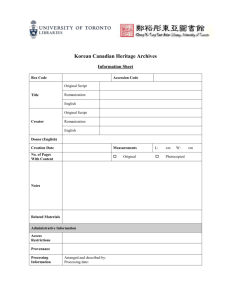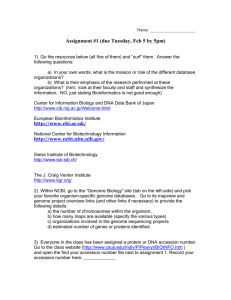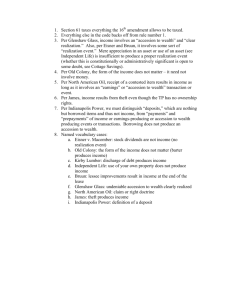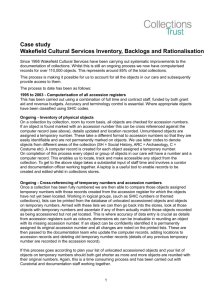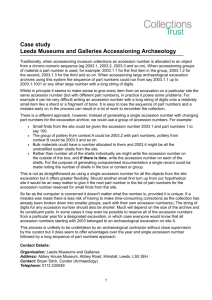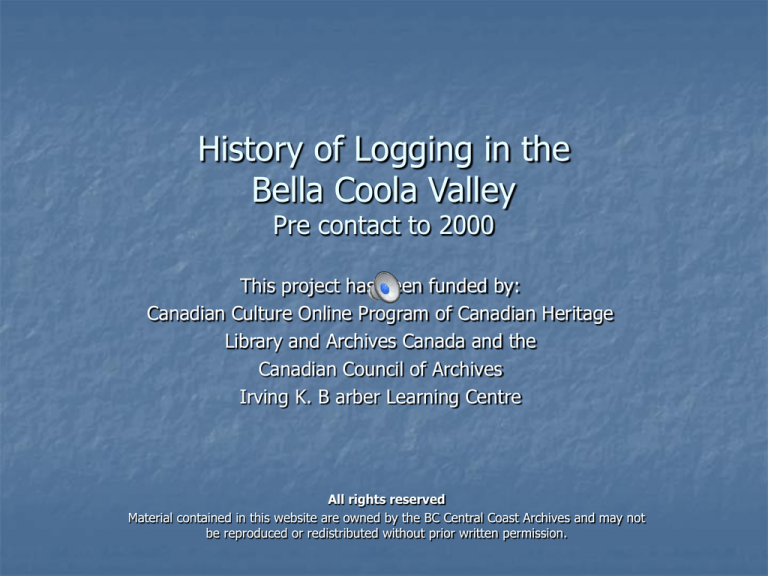
History of Logging in the
Bella Coola Valley
Pre contact to 2000
This project has been funded by:
Canadian Culture Online Program of Canadian Heritage
Library and Archives Canada and the
Canadian Council of Archives
Irving K. B arber Learning Centre
All rights reserved
Material contained in this website are owned by the BC Central Coast Archives and may not
be reproduced or redistributed without prior written permission.
Q’umk’wts (Bella Coola) Village - 1890
Accession # 2000.205.001P
The First Nations
people were the
first to log the
Bella Coola Valley.
The Cedar tree
was used for many
items of every day
living including
mats, utensils,
baskets and
clothing.
Wood was
harvested for
housing, canoes
and ceremonial
items.
The largest use of
wood at this time
would have been
for heating and
cooking fuel.
Nuxalk - Tools
The diagram above illustrates how the bark of cedar trees was harvested for use as clothing and
weaving. This produced what is now referred to as a culturally modified tree.
Recommended reading for more information. “Cedar” by Hilary Stewart
See reference page for source of diagram.
Culturally Modified Tree
Accession # 2009.001.003P
This cedar tree is an example of a culturally modified tree probably done by explorers
in the 1800’s.
Spoon Canoe
Accession # 2002.001.041P
Logs would have been processed with hand tools right at the cutting site.
These canoes were designed for river transportation and fishing the Eulichon.
1893
These two men are using broadaxes to hew
timbers for building homes.
Accession #2007.007.007.017P
With the coming of the Norwegian
settlers, land clearing for farming and
building began in earnest.
Logging became a way of making money
when farming wasn’t enough.
Image #g 00977 courtesy of Royal BC Museum, BC Archives
Manually Felled Trees
Accession #2006.029.001P
Trees of this size would take several hours to fall.
Manually falling trees is still done today with power tools making the job much faster.
Snootli Mill 1900-1920
Accession # 2003.016.091.002P
Logs for the mills came from private lands in the immediate area.
At this time lumber from these mills would most likely have been used locally rather than
exported.
Stamp Hammer
Accession #003.001.002
Accession #991.001.009
The stamp hammer was used on the end of logs to identify the owner.
This was a government regulation used to collect stumpage fees.
Accession #003.001.001
Steam Donkey
Accession #2007.029.025P
This is a steam donkey being used to yard timber.
The Owens’ brothers built a mill on the outskirts of “Old “Town” Bella Coola along the
Necleetsconnay river that would have been powered by a converted steam donkey.
Ocean Falls Sawmill
Accession #2006.001.009P
Ocean Falls’ first sawmill was built in 1909 by Ocean Falls Company.
The Bella Coola Pulp and Paper Company organized and staked leases on approximately 80,000
acres which, ultimately provided the foundation for pulp and paper projects and the sawmill in
Ocean Falls.
Native Logging Company
Accession #2002.001.457P
Accession #2003.014.029P
Accession #2009.016.021P
In 1904 the Nuxalk Nation were logging the
Native Reserve located on the large adjoining
river flats between the Bella Coola and
Necleetsconnay rivers.
First Nations people devoted the fall and early
winter to logging for local mills. This
complemented their seasonal pursuits such as
fishing and hunting.
1911 - South Bentick
Accession #2006.001.030P
First logging outfit in South Bentick Arm.
This steam powered barge would have been used to transport men, equipment and supplies to
and from the logging site.
Logging with Oxen
Accession #2004.029.194P
Olsen’s oxen,
affectionately
called “The Boys”
were used to clear
and haul logs to
the Mill.
Accession #2009.016.011P
Automation
Accession #2000.001.062P
This is a gas powered drag saw. This equipment only needed one man to operate
and replaced the two man cross cut saw for bucking up fallen timber.
Tidal Flats
Accession #2000.001.158
Boat houses were built at the base of Mt Fougner on inlet tidal flats.
The area shown here was mostly filled in by 1996 due to changes in the river flow.
Chain Saws
The first gas
powered chain
saw was patented
by A. Stihl in
1929.
Accession #2007.007.020
This 2000’s model of chain
saw has a 48 inch bar and
weighs approximately 20-30
lbs.
Accession #2000.004.067P
This 1940’s model of chain
saw weighed approximately
50 lbs. and was operated by
two men.
Accession #2009.016.002P
Float Camps
Accession #2000.001.029P
Float Camps were used to house the
loggers in areas being logged close
to the shore. This is an easy way to
move the camp around the coast.
Supplies and man power were
boated or, as is more common today,
flown in.
Accession #2005.008.277P
Road Building
Accession # 2005.008.293P
Accession # 2006.001.035P
Temporary roads were built to skid out
logs to a collection point.
Some of these log roads would later be
graveled over and used for local roads.
Modern machines and equipment make road building
faster and more permanent.
When an area is logged out the roads are often
decommissioned so that vehicle traffic can no longer
access the area.
Spar Tree
Accession #2007.029.058P
Accession #2005.008.059P
This spar tree is powered by two Steam
Donkey’s that yard the logs to a central area.
This is a steel tower yarder. The method is
similar to the original spar tree.
It is now a two in one operation. It yards the
logs off the site and then loads the logs onto
waiting trucks.
Spar Tree
1932 Log Dump
Accession #2000_004_009P
Accession #2007.029.098P
Here the Spar tree was used to yard fallen
logs off of the hill side and down to the
water.
A Steam Donkey would have powered the
yarding lines.
Logs would also be
trucked to the log
dump site.
The logs are
collected in the
water to later be
boomed for shipping
to the mills.
Accession #2009.016.010P
A-Frames
An A-frame was used
to elevate the logs
and then slide the
load out to deep water
on cables running out
to a smaller A-frame.
This system was last
used in 1990.
Accession #2009.017.004P
Accession #2007.029.083P
Accession #2009.017.005P
High Rigger
Accession #2005.008.016P
Accession #2007.029.009P
Accession #2005.008.018P
Loggers were employed to climb the tallest trees and remove the limbs and top the trees.
This tree would then be used as a spar tree.
Ground Skidding
Accession #2000.001.171P
This was another method of getting logs out of the bush.
The arch behind the tractor is used to raise the front of the log off the ground so it
can then be dragged out of the bush.
Logging Companies
Accession #2000.238.015P
Viking Timber Company was the first outside logging company to set up business in the Valley.
The Company went bankrupt in 1940 and many of the unpaid workers joined together to form the
Northern Co-operative Timber and Mills Association. Later re-organized as Northcop Logging
Company Ltd.
Northcop Logging Company
Accession #2007.004.015
The Northcop Logging Co sawmill was built in 1952.
The sawmill actually began as a co-operative started in 1939 and in 1948 became a limited
company.
Truck Logging
Accession #2000.238.007P
In the late 1930’s trucks took over the transportation of logs to the local mills or seaside log dump.
Railway logging was done in areas such as Dean River, Green Bay, Quatna & Kimsquit but never in
the Bella Coola Valley.
Bulk Processing 1960
Accession # 2005.008.119P
Self loading/offloading barges were used for transportation of logs to the mills on Vancouver Island
and the lower mainland.
Log Boom
Accession #2005.008.071P
Bundles of logs were collected on land and then slid into the ocean and stored in boom grounds
Stronger more solid booms called a “Davis raft’ were used in order to tow the logs across the open
ocean.
Grapple Yarder
Accession #2005.008.049P
Grapple yarders’ took over as the preferred high lead yarding machinery
Accession #2005.008.147P
Loaders
Accession #2005.008.277P
Accession #2005.008.100P
This is a hydraulic loader
This is a front end loader
Line Loaders
Accession #2005.008.122P
Accession #2005.008.148P
Small Scale Private Logging
This is a Hand Logging operation.
Accession #2008.007.042P
Hand falling operations are carried
out to remove diseased and
unsafe trees.
Accession #2008.007.027P
Helicopter Logging
Accession #2008.007.066P
Accession #2008.007.073P
Helicopter logging was first introduce to the valley in 1993.
It can be very expensive and is often used in sensitive areas where logging roads are not possible.
Competition
Fall Fair 1972 –
Winner Tommy Gee
Log Bucking 17inch
log – 40 seconds
Accession #2009.001.052P
Competition between
loggers was a great
spectator sport and
still is.
Off Loading
Image #i 2736 courtesy of Royal BC Museum, BC Archives
Image #i 2731 courtesy of Royal BC Museum,
BC Archives
Bundles of logs were brought by truck to the wharf
where they would be off loaded into the water
using an A-frame system and then boomed for
transport.
Reference
“Up Coast Forests and Industry on British Columbia’s North Coast 1870-2005” by
Richard A. Rajala
“Naming and Claiming A Visual History of the Bella Coola Estuary” UBC School of
Architecture and Landscape Architecture
“Kimsquit Chronicles, Dean River, British Columbia” by James Sirois
“Rhymes of a Western Logger”, by Harbour Publishing
Log Terms/WordsHand out available with this presentation
For copies of any of the photos in this presentation please complete the forms found
on our web site.
The End

